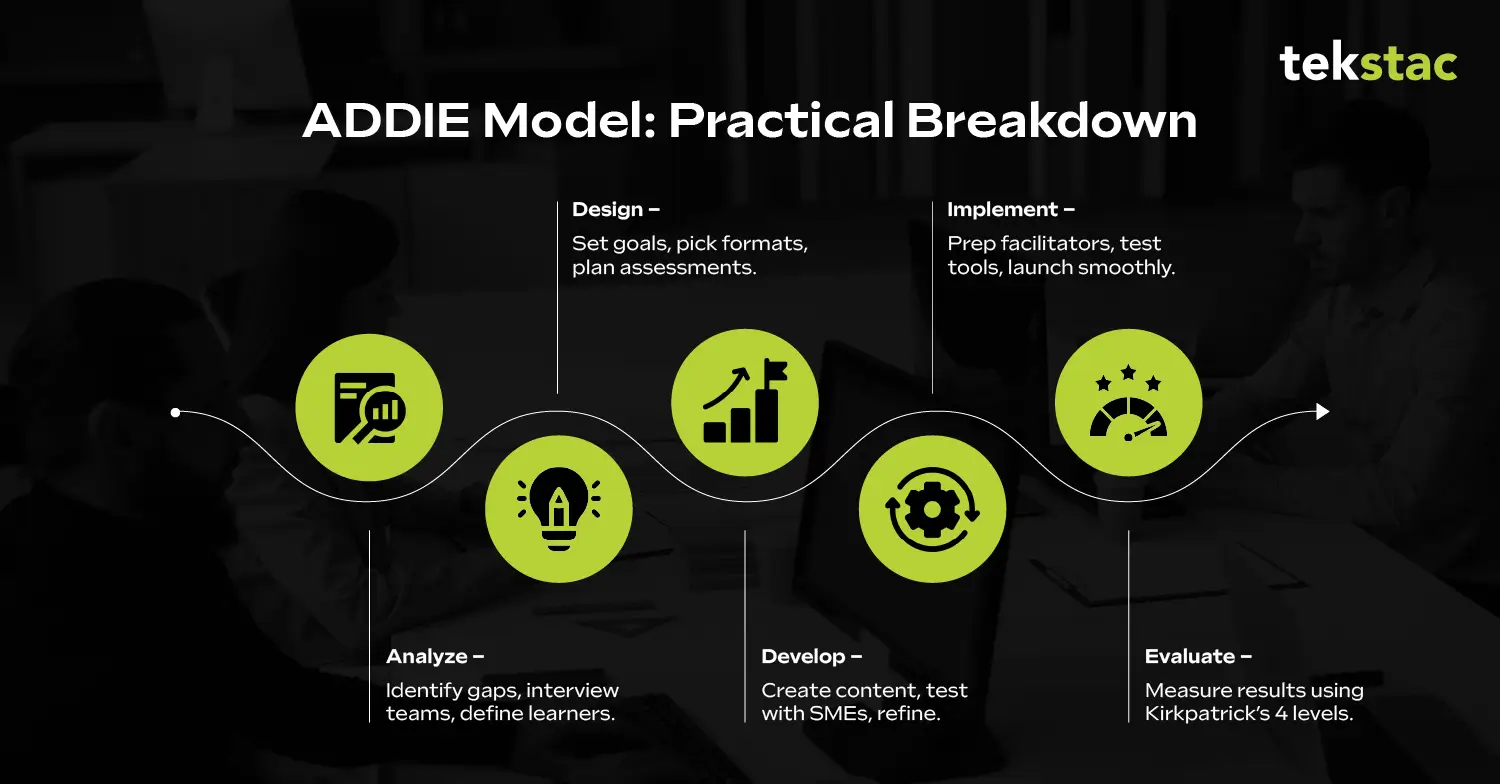A Practical Guide to Using the ADDIE Model for Talent Development

Almost half of the skills possessed by the present workforce is likely to become outdated in a mere two years.
Now, organizations have a challenge: “How do we continuously build talent in order to catch up with technological advancements?”
Most organizations tend to respond to skill shortages only after they have significantly affected performance, causing expensive delays. There’s a need for a disciplined, systematic approach to talent development that deals with business needs as they occur but also prepares for future requirements.
The ADDIE model provides a framework to design such learning programs. In this blog, let’s discuss in-depth how this model functions and how you too can apply ADDIE to talent development in 2026.
What Is the ADDIE Model? Definition and Why It Matters in 2026
The ADDIE model is a five-step phase for designing and implementing learning programs. It is an acronym for Analyze, Design, Develop, Implement, and Evaluate, representing five unique phases that walk you through from recognizing a learning need to measuring its business consequence.
The World Economic Forum reckons that 40% of the most important skills needed in the labour market will shift because of AI, automation, and evolving job roles by 2030. Meanwhile, L&D budgets are increasing, as 85% of employers intend to implement upskilling approaches between 2026–2030. This goes on to explain that organizations are betting heavily on talent development but require established, systematic models such as ADDIE that ensure desired results.
ADDIE Model Framework: Phase-by-Phase Breakdown
In the ADDIE model, each step forms the building block for the subsequent step, making a pathway from business needs identification to the delivery of effective learning solutions.
Make sure not to skip any stage, as the whole process gets compromised. For instance, if you don’t examine the correct problem, your training and development program will be off the target, and you will end up with training that fails to address performance gaps. This also results in wasted resources, unmotivated learners, and no measurable effect. Any workforce upskilling method must follow a structured approach to be effective.

Here’s a practical phase-by-phase ADDIE model breakdown so you can implement practically:
Phase 1: Analyze – Identifying Skill & Performance Gaps
Before you build anything, you need to know what business problem your learning program is solving. The Analyze phase anchors your learning intervention to a real-world business problem. It pinpoints the exact performance gap your employees face and why it exists. In other words, you’re diagnosing a business problem that learning might help fix.
In most organizations, performance gaps show up subtly. Whatever the case, the problem is always reflected in business metrics: attrition, ramp-up time, NPS, conversion, quality scores, and so on. This phase helps you trace those symptoms to specific skills, behaviors, or knowledge gaps.
Start with the business problem: The first step is identifying the problem. This step aims to understand why performance is lagging and whether a learning intervention is the right response. The more straightforward your diagnosis, the more focused and effective your solution will be.
- Review recent business KPIs to spot underperformance
- Identify departments or teams where output has dipped or errors have increased
- Interview managers to surface recurring workflow or behavioral issues
- Map any recent process, policy, or structural changes that may have caused confusion
- Write a 1-2 sentence problem statement defining the gap
Talk to stakeholders: Interview stakeholders, such as managers, high performers, underperformers, and cross-functional teams to identify the challenges and behaviors that are causing the issue.
- Interview managers and employees across levels
- Ask where people struggle most and what behaviors impact success
- Explore recent tool, process, or team changes causing friction
- Identify what people currently do to solve challenges, and what’s missing
Understand who you’re designing for: Consider your audience’s real work context. Consider their roles, daily challenges, tools, and learning preferences. Create a simple learner profile that highlights their pain points and blockers.
According to Deloitte, companies that follow structured learning models like ADDIE are 3.6x more likely to report measurable improvements in employee performance.
Phase 2: Design – Mapping Learning Objectives to KPIs
This stage transforms the findings gathered in Phase 1 into a roadmap that directs the creation of training and development materials. The intention here is to develop an elaborate map that links learning outcomes to changes in behavior and measurable business outcomes. Prepare yourself for providing answers to questions such as:
- What specific learning objectives will close the performance gap?
- Which instructional strategies and formats will engage your learners?
- How will you sequence the content for maximum impact?
- What assessment methods will confirm learners are applying new skills effectively?
Define clear learning objectives: Start by crafting your business problem into well-articulated, measurable learning goals. These need to be precise, actionable, and geared toward behavior or skills that have a direct influence on performance.
- Write objectives that answer: “What should learners be able to do differently after training?”
- Use action verbs (e.g., demonstrate, apply, analyze) to ensure clarity
- Align objectives with the desired business outcome defined in Phase 1
Choose the right learning strategies and formats: Select instructional methods that fit the audience’s preferences, context, and learning goals. Look at microlearning strategies, application based learning, workshops, simulations, or blending learning. Consider accessibility, time constraints, and resource availability. Make sure to sequence learning to progress smoothly from foundational knowledge to mastery along with practical applications.
Plan assessment and success metrics: Design formative assessments to reinforce learning during the program and plan summative assessments to validate skill adoption at the end. Ensure to align assessment criteria with business success metrics established earlier.
Phase 3: Develop – Building Learning Content and Assessments
The development phase is where your learning solution comes to life. In this production stage, you create and assemble all training materials. This demands collaboration to ensure content quality, relevance, and consistency with learning objectives. It’s also the time to integrate tools and technology that will help deliver the program smoothly. Build drafts, test them internally, gather feedback, and refine them before launch. This cycle helps catch gaps early.
- Ensure every material directly supports your defined objectives and reflects real learner challenges
- Engage subject-matter experts early on to review and validate the quality and applicability of your content
- Add examples and anecdotes that connect with learners’ everyday activities
- Plan frequent check-ins and leverage collaborative tools to track versions, feedback, and approvals easily
- Run soft launches, collect structured feedback through surveys or interviews, and refine content
Phase 4: Implement – Delivering the Training Program
After your learning materials are refined and approved, it’s time to implement the learning program in real life. This step guarantees the training launch is smooth and that learners can interact optimally. Therefore, it calls for extensive planning and coordination to prevent glitches
Prepare trainers and facilitators: Provide thorough briefings, detailed facilitator guides, and rehearsals if needed.
Set up the learning environment: Ensure that your LMS, virtual classroom, or physical space is fully prepared before launch. Test all technical elements, including access, multimedia playback, and interactive tools. Confirm that learners have the right permissions and resources.
Communicate early with learners: Share program objectives, schedules, and how learners can access materials or sessions. Provide clear instructions and support contacts for any technical or content questions.
Phase 5: Evaluate – Measuring Learning Impact and ROI
Evaluation is the vital last step in the ADDIE model, where you compare the success of your learning program against initial objectives. This step makes sure you are aware of the influence on the learner performance as well as the larger business goals. Without evaluation, all your work may be wasted or incorrect.
You need to assess whether learners have acquired the intended skills or knowledge and, more importantly, if their behavior or performance has improved on the job. This data guides future iterations and helps justify training investments. Use a combination of quantitative and qualitative methods to gather comprehensive insights. Look beyond immediate reactions and track long-term changes wherever possible.
Focus on multiple levels of evaluation: Kirkpatrick’s model is a proven framework here:
- Level 1: Reaction: Did learners find the training relevant and engaging?
- Level 2: Learning: Did they absorb the content and develop the skills?
- Level 3: Behavior: Are they applying what they learned on the job?
- Level 4: Results: Is the business seeing measurable improvements tied to training?
Collect data methodically: Use surveys, quizzes, interviews, performance metrics, and observation to collect data. Evaluate at multiple points, such as immediately post-training, 30 days after, and ideally after 90 days to track sustained impact.
Keep in mind that Phase 5 is not a one-time activity. Use your findings to identify gaps, refine content, enhance delivery, and scale successful elements.
ADDIE Model Case Study: How IBM Transformed Leadership Talent
Here is one company that successfully implemented the ADDIE model for talent development:
IBM
In the late 1990s, IBM felt a vanishing sense of leadership readiness. The business diversified across borders and business units, yet first-line managers were unprepared. The transition from individual contributor to leader was shaky, and managers lacked a shared understanding of good leadership. That’s when IBM rolled up its sleeves and brought in an old and sharp framework, the ADDIE model, turning it into its own Basic Blue training program. The fourth tier of the program was defined as the Evaluation phase of ADDIE.
Analyze: IBM recognized that first-line managers were unprepared for leadership roles. Too often, they emerged from individual contributor roles lacking key managerial skills. Their audit revealed critical gaps in delegation, feedback, and team management.
Design: IBM designed Basic Blue as a 4-tier e-learning blended program, with three online tiers being articles, simulations, and job aids. This was followed by a final in-person “Learning Lab” classroom session.
Develop: IBM produced multimedia-rich content, Manager QuickViews (editable Q&A databases), and simulations.
Implement: Basic Blue was delivered globally. First, online tiers were completed, followed by a week-long classroom experience. Completing digital tiers was mandatory before attending the Learning Lab.
Evaluate: IBM measured performance impact by identifying outcomes like better team management.
Ultimately, based on its early deployment, IBM achieved an ROI of 2,284% in 2001. After launching Basic Blue in 2000, IBM also generated $16 million in savings, and broader e‑learning programs saved $200 million that same year.
How to Embed the ADDIE Model into Your Talent Development Strategy
At the heart of every successful talent development strategy lies one core truth: structure. Just like IBM followed a clear, methodical framework when designing its Basic Blue program, every organization must begin with a solid foundation. This involves identifying skill gaps, structuring focused learning interventions, and ultimately putting in place mechanisms for monitoring and measuring impact.
Having a proper system, like Tekstac, is essential for L&D teams, especially those managing tech teams. Leading enterprises like IBM, PwC, and Accenture have embraced Tekstac to add more content and build repeatable, scalable, and trackable capability-building programs.
With the features below, Tekstac empowers HR and L&D teams to run talent development initiatives confidently at scale.
- Real-time skill gap analytics
- Immersive, hands-on labs
- Automated assessments
- Detailed progress tracking
Ready to apply the ADDIE Model to your organization? See how Tekstac helps design, deliver, and measure talent development programs with real ROI. → Book a demo
FAQs on ADDIE Model
1. What are the five phases of the ADDIE Model?
The ADDIE Model includes five structured phases: Analyze, Design, Develop, Implement, and Evaluate — used to build effective learning programs.
2. How does the ADDIE Model compare to the SAM Model?
ADDIE is linear and structured, while SAM (Successive Approximation Model) is iterative and rapid. ADDIE suits large, complex talent programs; SAM suits fast prototypes and agile learning needs.
3. Can the ADDIE Model be automated with learning technology?
Yes. Platforms like Tekstac automate skill gap analysis, learning path creation, hands-on assessments, and performance metrics — accelerating ADDIE-based learning programs at scale.
4. How does the ADDIE Model support talent development?
ADDIE aligns learning programs with business goals by diagnosing skill gaps, designing targeted training, and measuring improvement in on-the-job performance.





